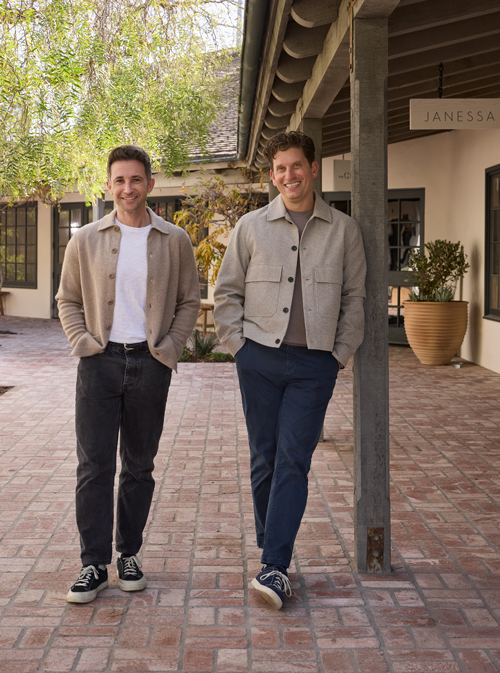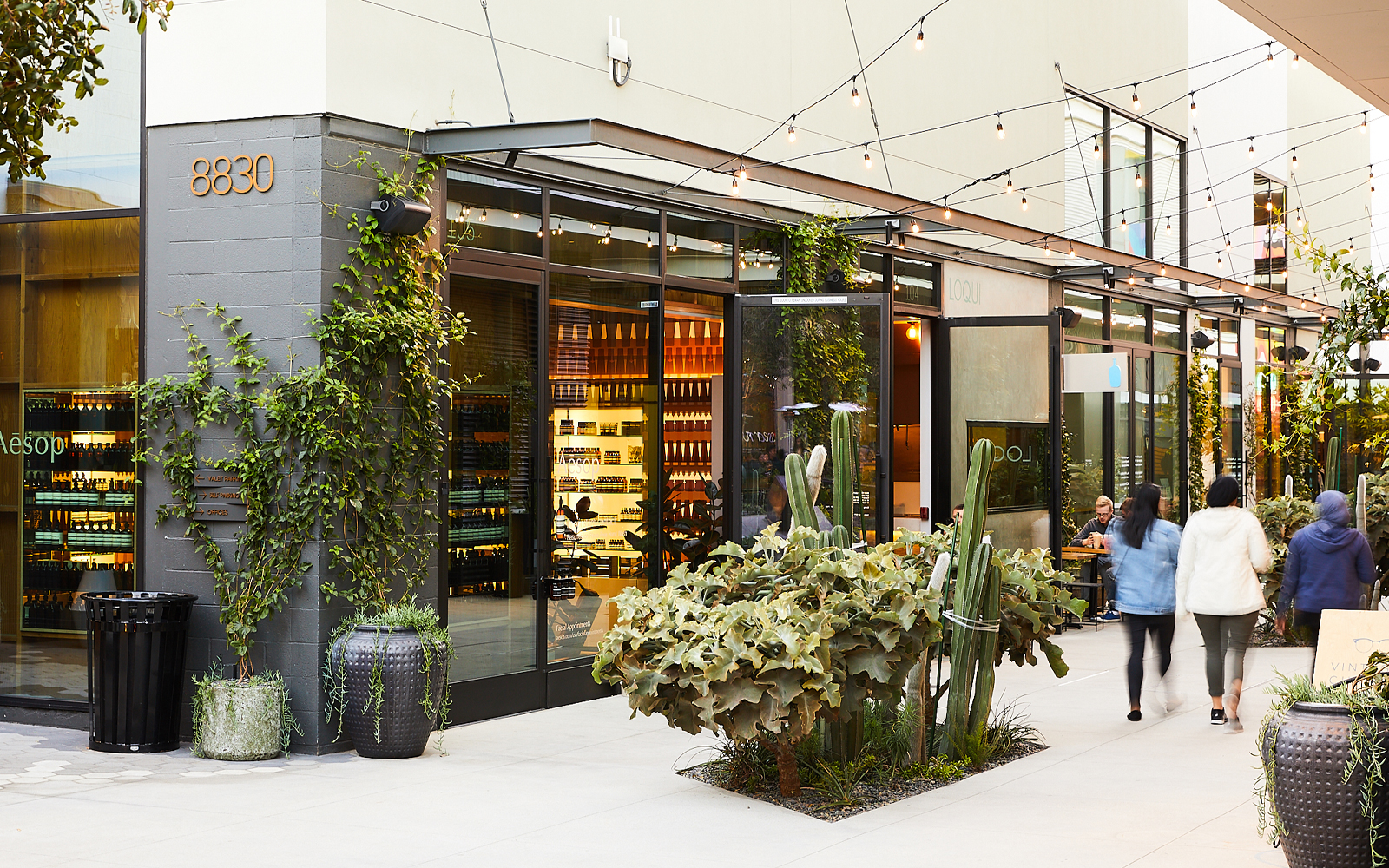The Runyon Group retail mix is very if you know, you know. They do deals with brands like Go Get Em Tiger, a coffee place that sells $7 almond macadamia lattes, accessories maker Janessa Leone for $337 wool fedoras and Brooklyn-based Catbird, where you can get “zapped” — code for having a bracelet fitted and then welded on your wrist.
Its development strategy is more straightforward. Co-founders Joseph Miller and David Fishbein ask: Will the latte-buying, fedora-sporting, permanent-bracelet-wearing shopper shop here?
For the company’s first two projects, the answer has been yes, so far. Runyon’s retail development Platform, and its work on the retail leasing for Row DTLA, in Los Angeles’ Arts District, already attract the discerning, sometimes to neighborhoods they never would set foot in if not for the hats and jewelry — a nod both to a global retail recovery and to Miller and Fishbein’s good eye.
Their most recent endeavor, the 38,000-square-foot Post Montecito, in Santa Barbara, could be the one to prove that this place-making exercise can scale, not just in cities but to the wealthy suburban centers where many of their potential customers are, and not just with brands that Runyon has curated, but also those it has taken a financial stake in.
Runyon spent $19.3 million on the property for the Post and then invested about $8 million to build it. All of its available pre-lease space is spoken for with tenants such as ready-to-wear label the Great, another Janessa Leone and a pop-up with Brooklyn brand Merlette. Coffee shop Little King opened its first location outside of its hometown in Buellton at the Post and next year is set to see the opening of new restaurant concept Bogavante.
“Montecito is such an incredible retail destination in terms of the demographics,” Miller said. “What we felt was missing was a unique, independent, curated mix of retailers and restaurants.”
“It’s more time outside of the cities where we think the wealthier millennials, who are our customers, are moving.”
Key to understanding the Runyon Group’s goals are two other boutiques: one for men, the Optimist, and another for women, named Teller. The two shops are retail concepts created by Runyon itself, with a dedicated, 15-person team the company directed to set the tone for how all their projects ought to be merchandised. The venture — which takes Runyon beyond development or brokerage — also serves as proof to prospective tenants that Runyon’s got skin in the game.
The firm invested in Los Angeles apparel brand Buck Mason and Go Get Em Tiger, which has solidified it as more than just a developer. However, the two don’t see the in-house retail or ventures divisions eclipsing the bread-and-butter development and leasing from a business standpoint.
“We have our hands full, number one,” Miller said. “Number two, there’s so many incredible operators in so many spaces. We would never want to really go into that same business.”
Instead, their core competency remains the bigger picture: remaking communities through retail.
Pioneering is tough
Runyon takes its name from the popular Hollywood hiking spot Runyon Canyon. Miller and Fishbein started out helping specialty brands, such as upscale skincare label Aesop and Blue Bottle Coffee, find the right real estate as they expanded beyond San Francisco.
In the early 2010s, the duo did plenty of leasing on Abbot Kinney Boulevard in Venice and Fillmore Street in San Francisco — high streets, in major cities.
They got into development with Platform, which opened in Culver City in 2016. The following year, they were on a tear as they leased up the 32-acre Row DTLA on the outskirts of downtown Los Angeles’ Arts District. (The Row was developed by an investor group led by Atlas Capital.) Then there was consulting for Rick Caruso’s Palisades Village, which opened in 2018, followed by consulting work on Rockefeller Center in New York in 2019.
Developing Platform was not easy.

“When we bought the property in Culver City, it was by no means a dangerous neighborhood, but it was certainly a very industrial neighborhood,” Fishbein said. “It took a lot of trials and tribulations and blood, sweat and tears to will that district of Los Angeles into a destination where people from around the city wanted to come.”
It took several years for Los Angeles’ higher-end demographic to understand Platform. Now, more than a million visitors come annually to shop, dine and attend events.
The Row was perhaps even more difficult given its size and the Arts District’s lack of connectivity or walkability from other downtown neighborhoods.
The Arts District has seen some of the greatest change among downtown’s neighborhoods with the influx, over the past few decades, of art galleries, Michelin-star restaurants and live-work lofts. That new wave included the openings of the Hauser & Wirth gallery, luxury fashion boutique Dover Street Market and Soho House’s members-only club Soho Warehouse. Within the Row’s offices alone, employers such as Conde Nast, Revolve, adidas and Shein have taken up space.
Seeing those kinds of changes is when it really hit them what kind of work they were doing. Miller and Fishbein weren’t just filling stores; they were creating whole city blocks at once.
“Pioneering neighborhoods is really tough,” Miller said.
It’s unclear whether Runyon’s retail success is quantifiable in the neighborhoods they’ve kicked on. JLL’s Ryan Hawley shied away from pegging how much rents have changed in the areas where Runyon’s developed or been charged with the lease-up of a project. That’s partly because comps don’t always exist, since Runyon has gone into areas where there was no retail previously.
“They’ve created a market and then reset rates for the broader areas because they’re attracting the right type of tenant,” Hawley said.
Miller and Fishbein’s timing is perhaps just right after retailers reset following the Great Recession. Large chains right-sized their footprints by shuttering underperforming doors, while the industry more broadly tailored store inventory to make it relevant to local shoppers. The rejiggering has in turn made retail as an asset class once again relevant to investors.
“We took our lumps during the financial crisis: retail needed to edit itself,” Hawley said of the asset class’s struggles. “The projects that Runyon has designed speak to that new era of retail.”
Millennials with money
In retail, the trade likes to talk about reinvention and what’s next in the same way designers plot out next season’s collection. For Fishbein and Miller, what’s next is shaking up the suburbs with more projects like the Post. Unlike the car lot that preceded Platform, and the string of industrial warehouses that got repurposed for the Row, the Post is taking over the Las Aves complex, once home to a med spa, dentist and other local businesses.
“From a demographics and demand perspective, Montecito is just a lot less pioneering and risky in our eyes than the areas we’ve done before,” Fishbein said.
Still, it’s an example of how tastes are clearly shifting in Southern California’s suburban markets.

A tour through Orange County shows it. In Costa Mesa, Shaheen Sadeghi’s The LAB (an acronym for Little American Business) was one of the first to introduce the concept of a boutique lifestyle center. That was more than 30 years ago when the former Quiksilver Inc. president redeveloped a goggle factory into what’s been dubbed the anti-mall.
More recent years have ushered in higher-end concepts such as DJM Capital’s Lido Marina Village, which was redeveloped in 2016. The project brought upscale LA retail and designers to Newport Beach, including Elyse Walker, Clare V. and Dôen. Almquist’s $70 million River Street Marketplace in San Juan Capistrano is the newest, opening this year with a tenant roster that includes Hobie, Toes on the Nose and Seager to highlight the city’s surf heritage.
Miller said he and Fishbein have spent the past year in conversations with family offices and private equity firms to understand where they’re deploying capital. These same firms, they said, are picking the brains of Runyon’s founders to understand what they’re targeting for future projects.
“We’ve spent a huge amount of time in the suburbs — Montecito, Laguna, Newport. It’s more time outside of the cities where we think the wealthier millennials, who are our customers, are moving,” Miller said.
Runyon Group hopes to have these millennials covered in places like San Diego, Orange County’s coastal communities, the East and South bays near San Francisco and also outside the state.
“The Post is a great indication of where we want to go with the business over the next couple of years,” Miller said. “We’ve had great conversations, and the capital markets are loving retail right now. For us, it’s all about finding those right locations.”
